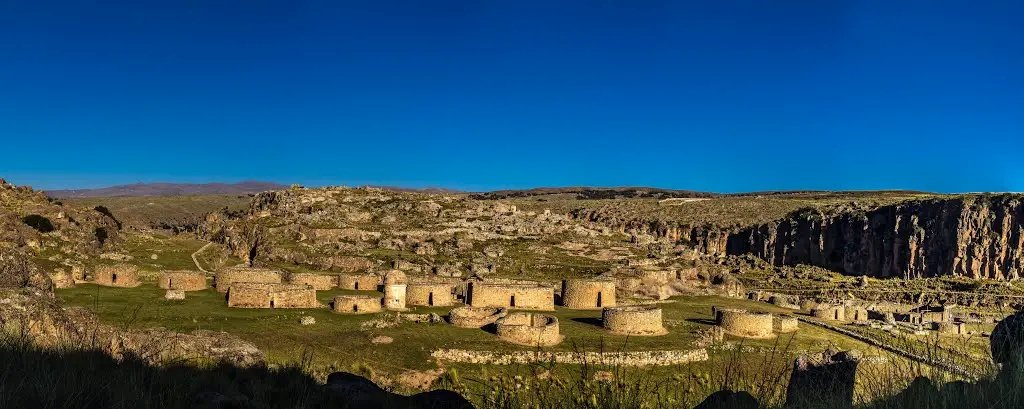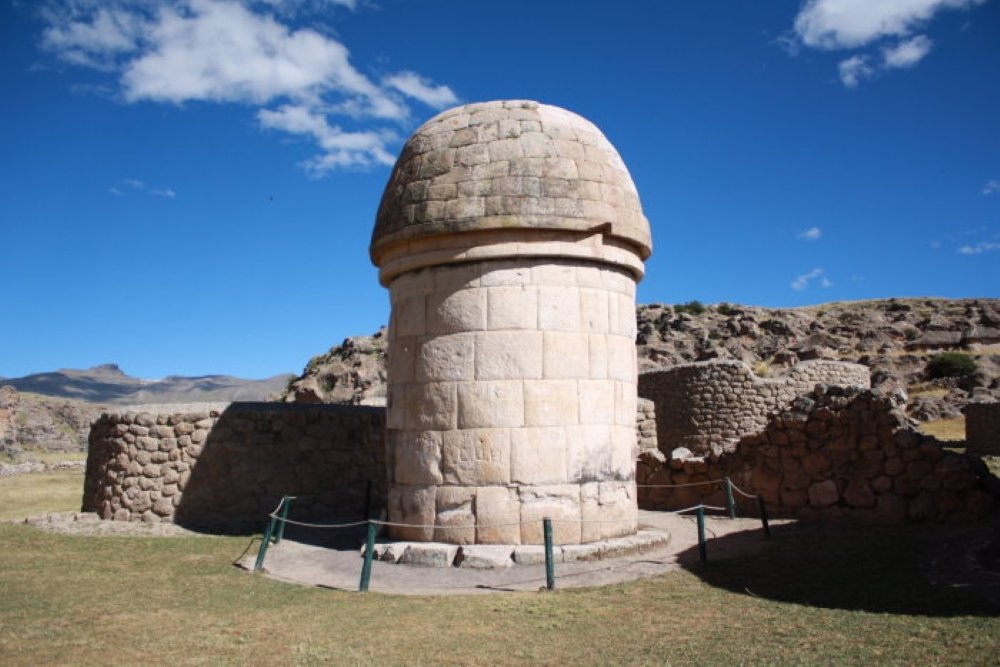Archaeological Center of Maukallaqta | Cusco
The Maukallaqta Archaeological Center, also known as Amukallacta, is located in the province of Espinar, in the region of Cusco, Peru. More specifically, it is located in the district of Alto Pichigua, within the aforementioned province. This archaeological complex is located in the Peruvian Andes, in a mountainous area at an altitude of about 4,000 meters above sea level.
The term “Maukallaqta” comes from the Quechua language, which was the main language of the Andean region during the pre-Columbian period and is still spoken by many communities in Peru and other countries in the region. In Quechua, “Maukallaqta” is composed of two parts:
- “Mauka”: this term has several possible meanings in Quechua, but is commonly translated as “hand”, “arm” or “side”.
- “Llaqta”: In Quechua, “llaqta” means “village”, “town” or “big town”.
Therefore, “Maukallaqta” could be roughly translated as “pueblo de la mano” or “pueblo del lado”. This denomination may have different interpretations depending on the specific cultural and historical context of the archaeological site. It is possible that the name is related to the physical layout of the site or to some geographic or symbolic feature associated with it.
History of the Archaeological Center of Maukallaqta | Cusco
The Archaeological Center of Maukallaqta, also known as Amukallacta, has a fascinating history dating back to pre-Inca times in the central Andes of Peru. Although research is still underway to fully understand its history, here is a summary of what is known so far:
- Pre-Inca origins: Maukallaqta was built by the Wari culture, a pre-Inca civilization that developed in the central Andes of Peru between the 6th and 11th centuries AD. The Wari were known for their skill in architecture and urban planning, and Maukallaqta was probably an important ceremonial and administrative center during their heyday.
- Importance in the Wari network: It is believed that Maukallaqta was part of a network of urban and ceremonial centers that the Wari built throughout the central Andes. These centers were connected by a complex network of roads and served as important nodes in the political and religious organization of the Wari civilization.
- Abandonment and later occupation: After the collapse of the Wari Empire, Maukallaqta was abandoned and subsequently occupied by other cultures, including the Incas. The Incas used the site for administrative and religious purposes, but not much is known about their specific occupation of Maukallaqta.
- Rediscovery and modern study: Maukallaqta was rediscovered by archaeologists in the 1970s, and has since been the subject of archaeological studies and research. These studies have revealed important information about the architecture, urban organization, and history of Maukallaqta, although there is still much to be learned about the site.
In summary, Maukallaqta is an important archaeological site that offers a window into the history and culture of pre-Inca civilizations in the Peruvian Andes. Its history reflects the complexity and diversity of the ancient societies that inhabited this region, and its study continues to shed light on the past of Peru and South America.

What to see in Maukallacta?
At the Maukallaqta Archaeological Center, also known as Amukallacta, there are several interesting features to explore and discover. Although not as famous as some other archaeological sites in the Cusco region, Maukallaqta offers a fascinating window into pre-Inca culture and ancient engineering. Here are some things to see and do in Maukallaqta:
- Plazas and architectural structures: Explore the site’s plazas and architectural structures, including temples, residences, agricultural terraces and stone walls. Observe the skill and precision with which these buildings were constructed, and contemplate their distribution across the mountainous landscape.
- Irrigation systems: Observe the irrigation systems that have been discovered at Maukallaqta, which show the advanced hydraulic engineering of the ancient inhabitants of the site. Study how they channeled water from nearby springs to irrigate their fields and maintain agriculture in the high Andes.
- Rock Art: Look for petroglyphs and rock engravings found at the site. These artistic representations may provide clues to the worldview and religious beliefs of the ancient inhabitants of Maukallaqta.
- Panoramic views: Enjoy the breathtaking panoramic views of the Andean landscapes that Maukallaqta offers. Its location high in the mountains provides a spectacular view of the surrounding valleys and peaks.
- Guided tour: Consider joining a guided tour with a local archaeologist or tour guide who can provide detailed information about the history, culture and architecture of Maukallaqta. Learning from an expert can enrich your experience and help you better understand the significance of the site.
Exploring Maukallaqta is a unique opportunity to immerse yourself in the history and culture of the ancient inhabitants of the Peruvian Andes, and to appreciate the natural beauty of the region.

How to get to Maukallaqta?
Getting to the Maukallaqta Archaeological Center in Espinar, Peru, may require some planning due to its remote location in the Andes. Here are some options and recommendations for getting to the site:
- By road from Cusco
The most common route to get to Maukallaqta is from the city of Cusco. You can take a bus or hire a private transport service from Cusco to Espinar, the province where Maukallaqta is located. From Espinar, you can continue your trip to the archaeological site by local transport, such as cabs or motorcycle cabs. It is advisable to ask in Espinar about the availability of transportation to Maukallaqta, as it may vary according to season and demand.
-
Organized tours
Another option is to join an organized tour that includes a visit to Maukallaqta. Many travel agencies in Cusco offer tours that visit various archaeological sites in the region, including Maukallaqta. These tours usually include transportation from Cusco, specialized tour guides and can provide a convenient way to get to the site.
- On your own with a private vehicle
If you have access to a private vehicle, you can drive from Cusco to Espinar and then to Maukallaqta. However, be aware that some parts of the road can be difficult to travel, especially during the rainy season. Make sure you have a vehicle suitable for roads in mountainous conditions and check road conditions before traveling.
Hiking: If you are looking for a more adventurous experience, it is also possible to reach Maukallaqta by hiking. However, be aware that this will require careful planning, as the trail can be long and demanding, especially due to the altitude and mountainous terrain.
Before embarking on your trip to Maukallaqta, be sure to research current conditions and plan your route in advance. In addition, it is advisable to consult with local authorities or tourism experts for up-to-date information on accessibility and site conditions.

Recommendations to visit Maukallaqta
Here are some recommendations for visiting the Maukallaqta Archaeological Center in Espinar, Peru:
- Physical preparation: Maukallaqta is located in a mountainous region at a considerable altitude, so it is important to be physically prepared for the visit. Do altitude acclimatization exercises before arriving and take water with you to stay hydrated during the hike.
- Dress appropriately: Wear comfortable clothing suitable for hiking, including layers of clothing to adapt to temperature changes that may occur throughout the day. Don’t forget to protect yourself from the sun with a hat, sunglasses and sunscreen.
- Appropriate footwear: Wear sturdy walking shoes, such as trekking boots or hiking shoes, that provide stability and protection on uneven terrain.
- Insect protection: Due to the location in a mountainous region, it is possible to encounter insects. Carry insect repellent to avoid bites.
- Respect for the site: When visiting Maukallaqta, respect the indications and restrictions established by local authorities to protect the archaeological site and its natural environment. Do not touch or climb on structures, and avoid leaving trash or causing damage to the environment.
- Expert guidance: Consider hiring the services of a specialized tour guide who can provide you with detailed information about the history, culture and architecture of Maukallaqta. A guide can enrich your experience by providing context and details that you might otherwise miss.
- Photographs and souvenirs: Don’t forget to bring a camera or cell phone to capture the most memorable moments of your visit. However, remember to be respectful when taking pictures and avoid interfering with other visitors or with the natural and archaeological environment.
By following these recommendations, you will be better prepared to enjoy your visit to Maukallaqta and to appreciate the cultural and historical richness of this important archaeological site in the Peruvian Andes.












